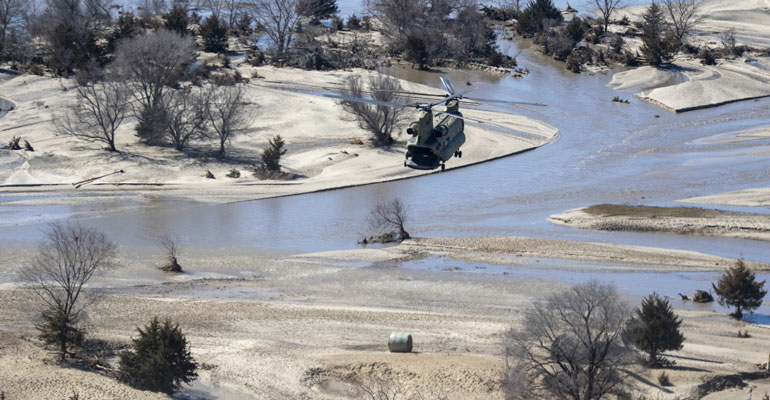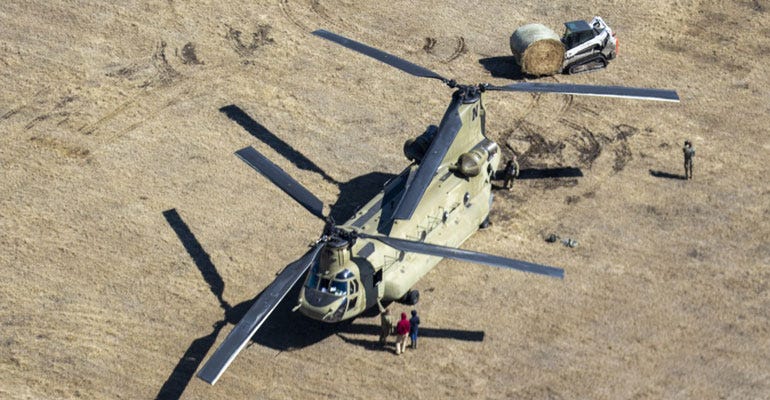
It was 70 years ago this past winter that Nebraska Gov. Val Peterson set up a command post in the basement of the Capitol building to manage Operation Snowbound, which was aimed at providing relief to humans and livestock across a 29-county disaster area.
Gigantic blizzards started in November 1948 that winter and didn’t end until February 1949. Over the course of the hard winter months, the Nebraska National Guard joined forces with the U.S. Army Corps of Engineers, U.S. Fifth Army, Civil Air Patrol, U.S. Air Force and the American Red Cross — as well as private contractors, farmers and ranchers — to rescue people and feed livestock.
Operation Haylift employed military C-45, C-47 and C-82 airplanes to drop hay bales to cattle stranded in the deep snow. The Guard operated bulldozers to open snowbound routes for farmers and ranchers to get out for supplies and to feed their livestock, and tracked vehicles called Weasels to help traverse the snowy terrain.
Operations covered more than 193,000 square miles in four states and may have saved more than 4 million cattle from starvation.
Flash forward to this past March. Once again, the Nebraska National Guard was called in to help rural residents and livestock struck by massive flooding and blizzards across the state. By mid-April, about one month after flooding began, 449 National Guard soldiers and airmen had served on statewide active duty on a total of 102 support air or ground missions during the disaster.
Some of the most dramatic scenes during the flooding were of Guard soldiers and airmen rescuing people stranded by floodwaters. They also employed a CH-47 Chinook helicopter with Company B, 2-135th General Support Aviation Battalion to deliver hay bales to stranded cattle — by either dropping the bales from the helicopter or landing to deliver them on the ground when possible.
“We send our condolences, first of all, to the families who lost loved ones in this flood,” says Maj. Scott Ingalsbe, Nebraska National Guard public affairs officer. “While we hope to never see a disaster like this, it is certainly a privilege for National Guard soldiers and airmen to be in a position to help. Individually, they made the decision to serve in order to be trained and ready when called upon.”

TOUGH CONDITIONS: The Nebraska National Guard employed a CH-47 Chinook helicopter to deliver hay to cattle stranded by flooding across Nebraska. Sometimes the hay bales were dumped from the air, but when there was a safe place to land, Guard soldiers preferred to deliver the hay on the ground to prevent destroying the bales.

The help didn’t come by accident. It is what Guard soldiers are trained for.
“The trucks hauling sandbags, drinking water and hay bales were ready to roll this spring thanks to maintenance those soldiers had done on their training weekends during the cold winter months,” Ingalsbe explains. “We strive to be ready to protect the health, safety and welfare of the people of our state.
“That is straight from our mission statement. In this case, the governor and our emergency managers determined that the National Guard could protect not only human lives, but also the livelihood of many Nebraska communities at risk during this flood.”
Guard support by the numbers
Ingalsbe put together a few numbers for Nebraska Farmer that tell the story of relief efforts made by Guard soldiers, as of April 15.
Transported 94 big round bales and 80 big square bales of hay and forage by ground or air.
Rescued 107 people by air, with 66 people rescued by vertical hoist.
Rescued five people by personnel on the ground.
Rescued 13 animals.
Delivered 90 pallets of bottled water and 11 pallets of medical supplies by ground.
Delivered 1,000 sandbags by ground and 1,100 vertical-type sandbags by air.
Transported one Bobcat T770 by aircraft.
About the Author(s)
You May Also Like






